Wazoo Survival Foraging Bandana
You can purchase it
here!
This bandana was a joint project between
Wazoo Survival Gear,
Alone star
Dr. Nicole Apelion, foraging author
Samual Thayer, and me.
#1. Burdock
Scientific name: Arctium minus, Arctium lappa
Abundance: rare
What: young leaves, flower stalks, 1st year root
How: young leaves raw, as tea, stir-fried, or boiled in 2-3 changes of water; peel green skin of plant stalks to reveal inner white core which is eaten raw or cooked; root of 1st-year plants less than 1" in diameter and must be peeled then boiled in two changes of water until tender; roasted roots for coffee
Where: open fields, sunny areas, woods
When: leaves in spring, flower stalks in summer, roots summer and fall
Nutritional Value: Roots contain some minerals, vitamins C & B6, and some calories. Leaves contain many vitamins and phytochemicals
Other uses: you can stick a bunch of the burrs together to make a crown, but that usually ends badly
Dangers: burrs are clingy, do not confuse with toxic Cocklebur (Xanthium pennsylvanicum)
Close-up of Burdock flower and seed bur.

Burdock stem.

Burdock root (partial).

More burdock roots. These are up to 32 inches long.

North American distribution of Burdock, attributed to U. S. Department of Agriculture.
 #2. Dandelion
Scientific name:
#2. Dandelion
Scientific name: Taraxacum officinale
Abundance: common
What: leaves, flowers, roots
How: young leaves in salad or boiled; flowers are used in wine; roots are roasted to make a coffee substitute or boiled for twenty-thirty minutes before eating
Where: yards, sunny
When: spring, early summer
Nutritional Value: Vitamins A, B, thiamine, riboflavin, minerals, and protein
Single dandelion plant.

A mature dandelion root can be twelve feet long! This one was a little over one foot.

North American distribution of Dandelion, attributed to U. S. Department of Agriculture.
 #3 Arrowhead
Scientific Name(s):
#3 Arrowhead
Scientific Name(s): Maranta spp. and Sagittaria spp.
Abundance: uncommon
What: tubers, young leaves, young flower stalks
How: boiled, roasted
Where: marshes, water
When: tubers all year, best in late fall and early winter; young leaves in early summer; flower stalks well before flower buds have opened.
Nutritional Value: carbohydrates
Dangers: Beware the similar-looking arrow arum, (Peltandra virginica) plant which has an arrowhead-shaped leaf and produces tubers same as Sagittaria species.
Arrowroot tuber (photo courtesy of
Samuel Thayer).

Arrowroot plants have many long veins radiating outwards from the center (palmate).

Arrowroot leaf and flower stalk with white flowers and unopened buds.

North American distribution of Arrowhead, attributed to U. S. Department of Agriculture.
 #4. Turkey Tail Mushrooms
Scientific Name(s):
#4. Turkey Tail Mushrooms
Scientific Name(s): Trametes versicolor, also called Coriolus versicolor
Abundance: common
What: mushroom
How: tea, tincture
Where: dead trees
When: spring, summer, fall, winter
Nutritional Value: medicinal
Dangers: beware of mimic False Turkey Tail crust mushroom (Stereum ostrea) and Gilled Polypore (Tremetes betulina)
Turkey Tail mushroom clusters. Many different colors are possible.


Turkey Tail mushrooms are barely as thick as a dime.

Turkey Tail mushrooms are connected to the dead wood with a narrow, thin point.
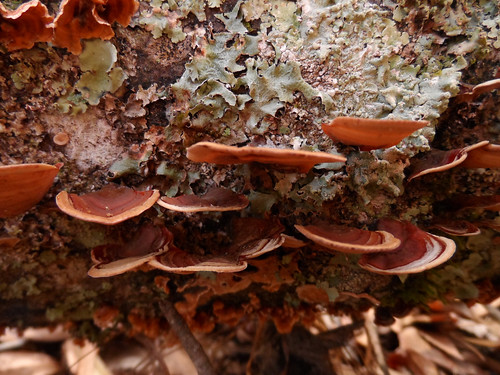
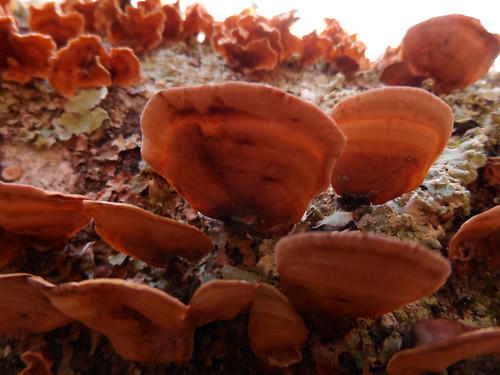

Close-up of top of Turkey Tail mushroom. This one is slightly larger than a US quarter coin.

Close-up of bottom of Turkey Tail mushroom. This one is slightly larger than a US quarter coin.

The mimic False Turkey Tail (Stereum ostrea) grows from a crust rather than a point.
Topside view of False Turkey Tails mushrooms.

Underside view of the "crust" covering most of the dead log.

The underside of mimic Gilled Polypore (Tremetes betulina) has gills rather than pores underneath.

North American distribution of Turkey Tail Mushrooms, attributed to U. S. Department of Agriculture.
 #5 Maple
Scientific name:
#5 Maple
Scientific name: Acer spp.
Abundance: common
What: Inner bark, seeds, leaves, sap
How: Boil inner bark or dry into flour, cook seeds, young leaves raw or cooked, boil sap down to syrup
Where: everywhere
When: anytime
Nutritional value: sugar in sap, protein and carbohydrates in seeds, minerals in leaves, carbohydrates in inner bark.
Maple leaves and almost-mature "helicopter" seeds.

Maple leaves.
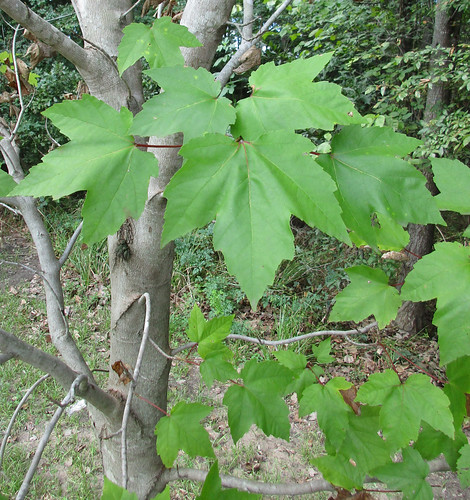
Red maple seeds. They are ready in the spring before the tree puts out its leaves.

Unripe Box Elder (also a maple) "helicopters". The seeds will be opposite the "fin". They'll be twice this size, dry, and tan when ripe.

Mature seeds of a
Box Elder.
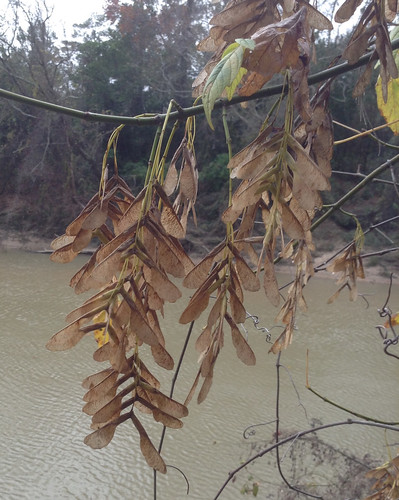 Box Elder
Box Elder compound leaf (top). They have five leaflets.

Tapping sugar maples is best done in late winter when daytime highs are 40-50F but below freezing at night. Texas weather rarely gives such a clear sign so some luck is involved in getting the timing right. Note that it takes boiling down 40 gallons of sap to get one gallon of syrup. Complete directions for making maple syrup and maple sugar are
HERE.
North American distribution of Maples, attributed to U. S. Department of Agriculture.
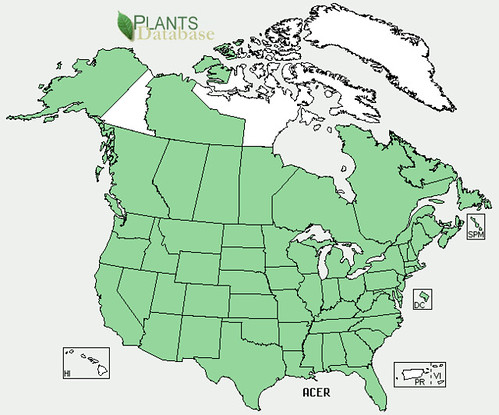 #6 Stinging Nettle
Scientific name:
#6 Stinging Nettle
Scientific name: Urtica chamaedryoides, U. dioica, U. urens
Abundance: common
What: leaves and young stems
How: cooked greens, tea
Where: woods, borders, abandoned areas, woods, sunny and shady areas
When: spring, early summer
Nutritional Value: Rich in vitamins A,C,D,K, many minerals, and high in protein.
Dangers: can cause skin irritations, handle while wearing leather gloves. Cook to remove stingers before consuming.
Close-up of stinging nettles (Urtica chamaedryoides).

Patch of stinging nettles (Urtica chamaedryoides).

North American distribution of Stinging Nettles, attributed to U. S. Department of Agriculture.
 #8 Wild Violet
Scientific name:
#8 Wild Violet
Scientific name: Viola species
Abundance: uncommon
What: Leaves, flowers
How: Leaves and flowers raw (great in salads), tea from flowers
Where: small, heart-shaped flowers in shady, moist areas
When: Winter (in Houston), Spring, early summer
Nutritional Value: very rich in vitamin A,C
Nutritional Value: Violets contain the chemical Violine which, in VERY large doses, can cause vomiting and diarrhea.
Wild violet plant.


Close-up of wild violet flower.

North American distribution of Wild Violets, attributed to U. S. Department of Agriculture.
 #9 Plantain
Scientific name:
#9 Plantain
Scientific name: Plantago species
Abundance: plentiful
What: leaves, young seed pods
How: raw, steamed
Where: Sunny fields, urban yards
When: Spring
Nutritional Value: minerals, vitamin B
Other uses: Rub mashed leaves on insect bites to relieve pain/itching
Redseed Plantain (Plantago rhodosperma)



Close-up of plantain leaf.
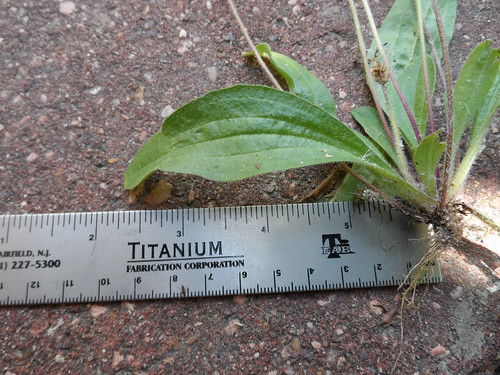

Really big plantains, probably Plantago virginica.


Plantago lanceolate

Close up of Plantago lanceolate flower/seed stalk.

Even closer-up picture of Plantago lanceolate flower/seed head.

Out in West Texas look for Woolly Indianwhesat plantain (Plantago patagonica).
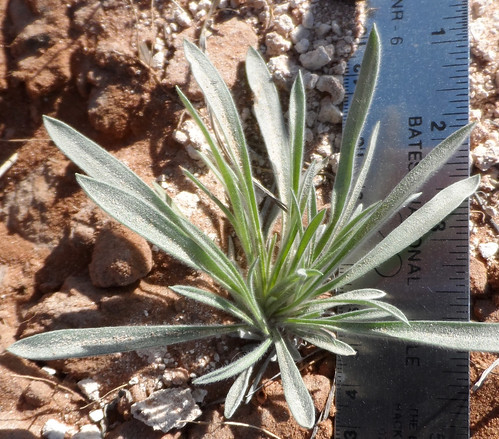
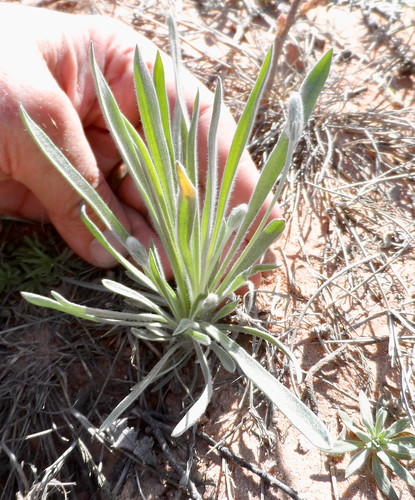

North American distribution of Plantains, attributed to U. S. Department of Agriculture.
 #10 Cattails
Scientific name:
#10 Cattails
Scientific name: Typha latifolia
Abundance: common
What: Tubers, shoots, male portion of flower, pollen
How: Tuber starch granules are removed by hand from fibers, young shoots cut from tubers, older stems can be peeled back to get soft, white edible pith, male (top) part of flower steamed before it become fluffy, pollen from male section is shaken into paper bag from flower and use as flour
Where: Shallow water
When: Tubers in winter, shoots in spring/summer, pollen and flowers in spring
Nutritional Value: Young shoots have low amounts of minerals. Pollen is high in protein. Tubers are high in calcium, iron, potassium, and carbohydrates.
Other uses: Fluff is good tinder and insulation, leaves can be woven into baskets and used to thatch huts.
Dangers: Fluff may cause skin irritation. Wash thoroughly before eating parts raw so as to avoid picking up any infectious, water-borne microbes.
Bullrushes/cattails



Close-up of cattail bases.

Cattail rhizome and new shoot at its tip.


Cattail tip, best cooked like asparagus.

Grilling up some cattail rhizome along with brats.
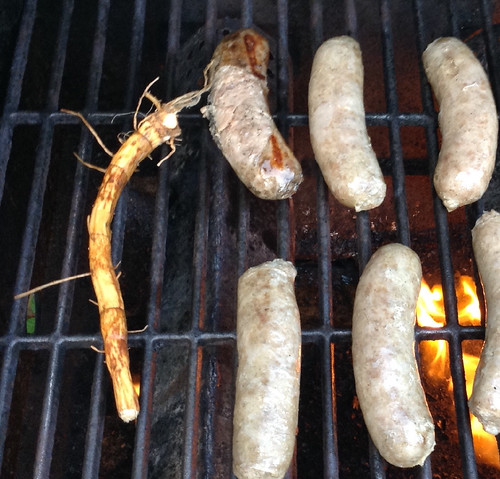
Peel off the outer, charred skin to chew up the starchy core.

A tender shoot.


Flowers (brown top is male portion, green part below male is female section)

Pollen coming from the male portion of the cattail flowerhead.

North American distribution of Cattails, attributed to U. S. Department of Agriculture.
 #11 Prickly Pear Cactus
Scientific name:
#11 Prickly Pear Cactus
Scientific name: Opunita lindheimeri
Abundance: plentiful
What: fruit (tunas), pads (nopalito), flowers, juice
How: peeled pads can be pickled, fried, made into jerky; fruit can be raw or blended into a smoothy/icee drink; juice from strained fruit can be drunk, made into ice cream, mixed drinks, preserves.
Where: sunny fields
When: fruit-late summer, pads-all year though younger pads taste better.
Nutritional Value: vitamin C, some minerals and omega-3 fatty acid
Dangers: The spines and tiny, fine hairs are very irritating and can even be fatal if lodged in the throat. Burn off the spines/hairs to remove.
Prickly Pear.


Close-up of prickly pear flower.

Ripe fruit.


North American distribution, attributed to U. S. Department of Agriculture.
 #12 Willow
Scientific name:
#12 Willow
Scientific name: Salix spp.
Abundance: plentiful
What: twigs, inner bark
How: tea made from chopped up twigs; inner bark is an emergency food and is eaten raw or dried and ground into flour
Where: woods, water, sunny fields, landscaping
When: twigs highest in salicylic acid in early spring; inner bark any time
Nutritional Value: inner bark contains carbohydrates
Other uses: Willows contain salicylic acid which is a precursor of aspirin.
Dangers: Salicylic acid can cause stomach upset in high doses and trigger Reye's syndrome in young children.
Mature willow tree.

Medium-sized willow tree.

Close-up of leaves.

Willow trunk

Boiled willow bark makes a beautiful, red-colored tea that reduces fevers, pain, and swelling due to its salicin converting to salicylic acid.

North American distribution of Willows, attributed to U. S. Department of Agriculture.
 Meet the Creators
Dr. Nicole Apelion
Meet the Creators
Dr. Nicole Apelion
Scientist, mother, educator, researcher, expeditionary leader, safari guide, herbalist and traditional skills instructor. A leader in the field of transformative nature education, Nicole is excited to share her knowledge and expertise of nature connection, indigenous knowledge, natural wellness and survival skills with the world.
Samual Thayer
Renowned author and forager and internationally recognized authority on edible wild plants. His mission is to promote responsible foraging, appreciation and conservation of Nature, and sustainable food production systems.
Dr. Mark "Merriwether" Vorderbruggen
Forager, chemist, author, inventor, adventurer, rogue botanist, husband, and parent!
Wazoo Survival Gear
A couple of NASA engineers designing compact, wearable survival kits that can be worn every day. After all, the only survival kit that works is the one you have with you when you need it. No one wants to feel helpless or hopeless so join the movement and practice self reliance. Be ready for any adventure life offers you.
Buy my book! Outdoor Adventure Guides Foraging covers 70 of North America's tastiest and easy to find wild edibles shown with the same big pictures as here on the Foraging Texas website.
















































































